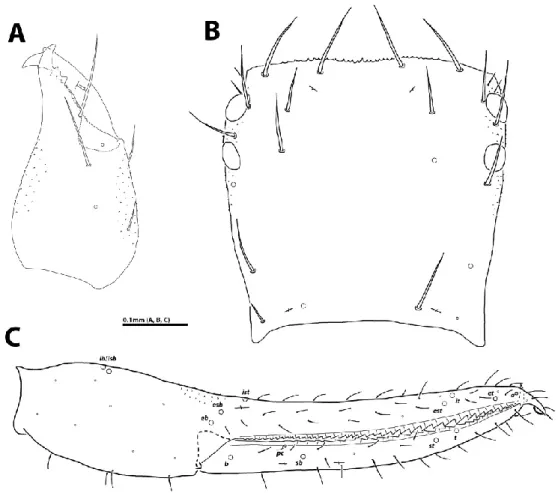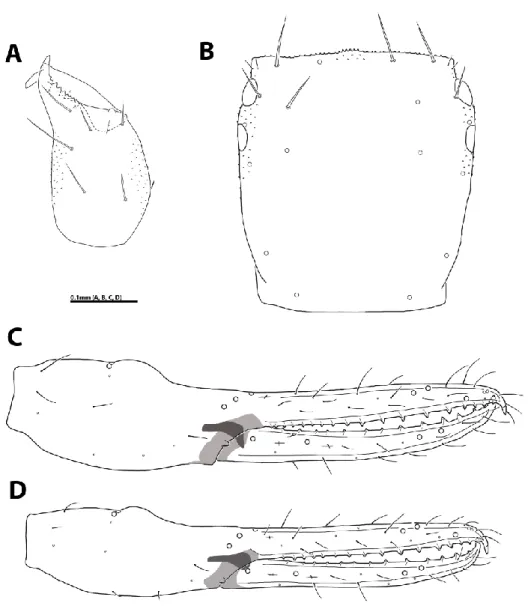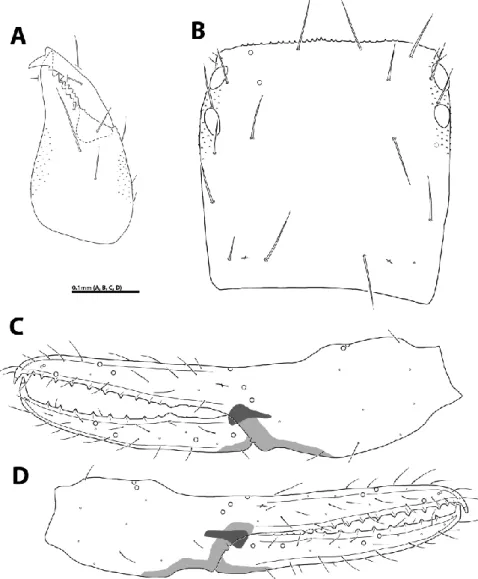Opusc. Zool. Budapest, 2020, 51(2): 115–121
New data on the pseudoscorpion family Chthoniidae (Arachnida:
Pseudoscorpiones) from Hungary
J.NOVÁK
János Novák,Hungarian Natural History Museum, Department of Zoology, Baross u. 13, H–1088 Budapest, Hungary. E-mail: novakjanos01@gmail.com
Abstract. Chthonius submontanus Beier, 1963, Ephippiochthonius romanicus (Beier, 1935) and Occidenchthonius parmensis (Beier, 1963) are firstly recorded from Hungary. The genus Occidenchthonius Zaragoza, 2017 is new for the country. A brief description and the relative figures are reported for each species. Fifty-seven species are currently recorded from Hungary.
Keywords. Central Europe, Chthonius, Ephippiochthonius, Occidenchthonius, faunistics, new records.
INTRODUCTION
seudoscorpions are small-sized terrestrial arthropods that range from 1 mm to 1 cm in body size (Harvey 2002). They superficially re- semble scorpions but lack a sting and a tail and are smaller. With more than 3500 (Harvey 2013) described species and 25 extant families (Bena- vides et al. 2019) they represent one of the four meso-diverse orders of Arachnida (Harvey 2002) and inhabit almost all terrestrial habitats.
The family Chthoniidae comprises twenty-nine genera and more than 600 species (Harvey 2013;
Zaragoza 2017) and belongs to the superfamily Chthonioideae, alongside with Pseudotyrannoch- thoniidae (Benavides et al. 2019). Tridenchtho- niidae and Lechtyiidae, two former families of hte superfamiliy, were reduced recently to subfami- lies of Chthoniidae as Tridenchthoniinae and Lechtyiinae (Benavides et al. 2019).
Although investigated from the second half of the 19th century, the pseudoscorpion fauna of Hungary is still poorly known. Occurrence data of 54 species belonging to eight families is known to date from the country (Novák 2012, 2015, Novák
& Harvey 2015, Harivey et al. 2018), of which 13
belong to three genera of Chthoniidae: Chthonius C.L. Koch, 1843 (9 species), Ephippiochthonius Beier, 1930 (3) and Mundochthonius J.C. Cham- berlin, 1929 (1).
The aim of the present study is to report the first occurrences of Occidenchthonius parmensis (Beier, 1963), Chthonius submontanus Beier, 1963, and Ephippiochthonius romanicus (Beier, 1935) in Hungary, with brief descriptions of the specimens found.
MATERIAL AND METHODS All specimens were collected by hand sam- pling, sifting or using pitfall traps. Representative specimens were cleared in lactic acid and examin- ed with a stereo- and a Zeiss Axioskop 2 com- pound light microscope. Drawings were made with the aid of a Zeiss Axioskop 2 microscope.
Measurements were made with the Olympus Soft Imaging analySIS work 5.0 software.
The specimens are stored in 70% ethanol and deposited at the Hungarian National History Museum (HNHM). All specimens are accom- panied and registered with an inventory number (HNHM Pseud-Nr).
P
Novák: New data on the pseudoscorpion family Chthoniidae in Hungary
RESULTS
Chthonius submontanus Beier, 1963 (Figures 1A–C)
Material examined. HNHM Pseud-1882: 1 ♂, Dobogókő, leaf litter of beech forest, sifting, 11.07.2013. leg. Klára Dózsa-Farkas & János Novák; HNHM Pseud-1891: 1♂, Szakonyfalu, 04.1958 leg. ???.
Short description of the main characteristics of the found males. Carapace, tergites, chelicerae and pedipalps pale brown. Hispid granulation on lateral surfaces of carapace and on cheliceral palm. Carapace subquadrate, epistome absent, an- terior margin dentate (Fig. 1B). Anterior eyes with convex lens, posterior eyes with flat lens.
Carapace with 20 macrosetae and 2+2 microsetae laterally, before the eyes; chaetotaxy: mm4mm:
6:4:2:4 (24). Four lyrifissures present, two at the ocular region and two near the posterior margin of carapace. Tergal chaetotaxy (I–X): 4-4-4-4-6-6-6- 6-6-6. Sternal chaetotaxy (II–X): 10:(3)9(3):(2)8 (2):6:6:6:6:6:6. Genital opening flanked by 6–7 setae on each side. Cheliceral palm with 6 setae, one seta on movable finger (Fig. 1A). Fixed cheliceral finger with 10–11, movable with 6–8 teeth and with an isolated apical tooth (di); gl ratio 0.56–0.59×. Spinneret prominent and api- cally rounded; rallum with 11 pinnate blades.
Serrula exterior with 11–15 blades, serrula inte- rior not seen. Pedipalpal coxa with 5 setae, in- cluding 2 on manducatory process; coxa I–IV: 2–
3 + 3 marginal microsetae; 4; 5; 5–6; coxa II with 5–8, coxa III with 3–5 spines; intercoxal tubercle bisetose. Fixed chelal finger with 32, movable with 22–24 teeth (Fig. 1C). Dental line of mo- vable finger ending between trichobothria b and sb. Trichobothria est-it at the level of st-t. Disto- paraxial seta of fixed finger sinuous. Coupled trichobothria pc closer to sb than to b.
Measurements (in mm) and ratios (in paren- theses). Body 1.20–1.60. Carapace length 0.40, width at posterior margin 0.34–0.37, width at the level of the eyes 0.42. Cheliceral palm with fixed
finger 0.31–0.32/0.18 (1.72–1.78 ×); movable finger 0.17–0.18. Palpal femur 0.44–0.48/0.10 (4.40–4.80 ×), patella 0.24/0.12 (2.00 ×); chela 0.73–0.74 (0.52–0.53 ×); hand 0.27–0.28/0.14, depth 0.14–0.15; fixed finger 0.46–0.49.
Remarks. Chthonius submontanus was de- scribed by Beier (1963a) from the Austrian Alps, where it was found in leaf litter and grass branches, and subsequently reported from Italy (Beier 1963b), Romania (Cîrdei et al. 1970), Switzerland (DeVore-Scribante 1999), and Ger- many (Drogla 2004). The species was redescribed by Gardini and the Romanian and Italian data were referred as dubious (Gardini 2009, Mahnert 2009). The characters of the new specimens from Hungary correspond well with the redescription of C. submontanus (Gardini 2009) therefore, I have no doubts about its identity. The species is new for the fauna of Hungary.
Ephippiochthonius romanicus Beier, 1935 (Figures 2A–C)
Material examined. HNHM Pseud-1894: 1♂, Tatabánya, 14.06.1960, leg. Imre Loksa. HNHM Pseud-1896: 1 ♂, 2 ♀♀, Tenkes Hill, 29.09.1960, leg. Imre Loksa.
Short description of the main characteristics of the found males and females. Carapace, tergites, chelicerae and pedipalps yellowish-brown. Hispid granulation on lateral surfaces of carapace and on cheliceral palm. Carapace subquadrate, epistome absent, anterior margin dentate (Fig. 3B). Anterior eyes having convex lens, posterior eyes with flat lens. Carapace with 18 macrosetae and 1+1/2+2 microsetae laterally, before the eyes; chaetotaxy:
m4m/mm4mm:6:4:2:2 (20/22). Tergal chaetotaxy (I–X): 4:4:4:4:6:6:6:6:6:6. Sternal chaetotaxy (II–
X): 10–11:(2–3)8(2–3):(1–2)8–10(1–2):6:4–6:4–
6:4–6:4–8. Male genital opening flanked by 6–7 setae on each side. Cheliceral palm with 6 setae and 1–2 microsetae laterally (Fig. 3A). Fixed cheliceral finger with 8–11, movable with 5–8 teeth and without an isolated apical tooth (di); gl ratio 0.53–0.57 ×. Spinneret prominent and
Novák: New data on the pseudoscorpion family Chthoniidae in Hungary
Figure 1. Chthonius submontanus (HNHM Pseud-1882). A: right chelicera, male, dorsal view;
B: carapace, male, dorsal view; C: right chela, male, lateral view.
apically conical. Rallum with 8–11 blades. Serrula exterior with 12–14 blades, serrula interior not seen. Pedipalpal coxa with 5 setae, including 2 on manducatory process; coxa I–IV: 3 + 2 marginal microsetae; 4–5; 4–5; 6–7; coxa II with 5–8, coxa III with 2–4 spines; intercoxal tubercle bisetose.
Hand of chela dorsally depressed at the level of ib–isb, with a hump distal to ib–isb. Fixed chelal finger with 16–18, movable with 9–13 teeth (Figs.
3C–D). Dental line of movable finger ending between trichobothria st and sb. Coupled tricho- bothria pc closer to sb than to b.
Measurements (in mm) and ratios (in paren- theses). Male. Body 1.2. Carapace length 0.38, width at posterior margin 0.35, width at the level of the eyes 0.39. Cheliceral palm with fixed finger 0.26/0.15 (1.73 ×); movable finger 0.15. Palpal femur 0.44–0.49/0.07–0.08 (6.13–6.29 ×), patella
0.20/0.10 (2.00 ×); chela 0.66–0.68/0.12 (5.00–
5.67 ×); fixed finger 0.38–0.40.
Females. Body 1.2–1.6. Carapace length 0.39, width at posterior margin 0.36, width at the level of the eyes 0.40. Cheliceral palm with fixed finger 0.26–0.28/0.15 (1.73–1.86 ×); movable finger 0.15–0.16. Palpal femur 0.48/0.10 (4.80 ×), patella 0.20/0.11 (1.82 ×); chela 0.68–0.74/0.14 (4.86–5.29 ×); fixed finger 0.39–0.40.
Remarks. Ephippiochthonius romanicus was described from Comana (in the former county of Vlaşca), Southern Romania (Beier 1935). Later, the species was reported from the other side of the Carpathians (Transylvania, Romania) (Beier 1939), Turkey (Beier 1963c), Rhodos (Greece) (Beier 1966), and Iran (Beier 1971). The Hun- garian specimens were collected in the southern part of the country. The characteristics of the new
Novák: New data on the pseudoscorpion family Chthoniidae in Hungary
Figure 2. Ephippiochthonius romanicus (HNHM Pseud-1896). A: right chelicera, female dorsal view; B: carapace, female, dorsal view; C: right chela, female, lateral view; D: right chela, male, lateral view.
specimens correspond well with the original description (Beier 1935). However, as the where- abouts of the type material is unknown, some modern characteristics of the species, e.g. setation of male genital opening and the situation of coupled sensilla pc could not be compared to them.
Occidenchthonius parmensis (Beier, 1963) (Figures 3A–C)
Material examined. HNHM Pseud-1895: 1♂, Nagykovácsi: oak forest, leaf litter, sieving 06.
11.2014, leg. János Novák; HNHM Pseud-1897: 3
♀♀, Tenkes Hill: 29.09.1960, leg. Imre Loksa.
Short description of the main characteristics of the found male and females. Carapace, tergites, chelicerae and pedipalps yellowish-brown. Hispid granulation on lateral surfaces of carapace and on cheliceral palm. Carapace subquadrate, epistome absent, anterior margin dentate (Fig. 3B). Anterior eyes with convex lens, posterior eyes with flat lens. Carapace with 20 macrosetae and 2+2 microsetae laterally, before the eyes; chaetotaxy:
mm4mm:6:4:2:4 (24). Two lyrifissures near
Novák: New data on the pseudoscorpion family Chthoniidae in Hungary
porsterior margin of carapace. Tergal chaetotaxy (I–X): 4:4:4:4:6:6:6:6:6:4. Sternal chaetotaxy (II–
X): 6-8: (3)8(3): (2)8–10(2):8:6:6:6:6:8. Male genital opening flanked by 7 setae on each side.
Cheliceral palm with 5–6 setae and 1–2 micro- setae laterally, movable finger with one seta (Fig.
3A). Fixed cheliceral finger with 5–6, movable with 6–8 teeth and an isolated apical tooth (di); gl ratio 0.52–0.56 ×. Spinneret prominent and api- cally rounded. Rallum with 11 blades; serrula ex- terior with approximately 12 blades, serrula inte- rior not seen. Pedipalpal coxa with 5 setae, 2 of them on manducatory process; coxa I–IV: 3 + 3
marginal microsetae; 4; 5; 6; coxa II with 5, coxa III with 2 spines; intercoxal tubercle bisetose.
Fixed chelal finger with 13–15 teeth, 2–5 of which being partially fused and forming an elevation at the proximal one third of the finger.
Movable finger with 10–11 teeth, 2–5 of which being partially fused and forming an elevation at the proximal one third of the finger (Figs. 3C–D).
On movable finger dental line ending between trichobothria b and sb. Trichobothria est-it at the level of st-t. Disto-paraxial seta of fixed finger sinuous. Coupled trichobothria pc situated distad to sb, at the level of fused teeth.
Figure 3. Occidenchthonius parmensis (HNHM Pseud-1895, HNHM Pseud-1897). A: right chelicera, female, dorsal view; B:
carapace, female, dorsal view; C: left chela, female, lateral view; D: right chela, male, lateral view.
Novák: New data on the pseudoscorpion family Chthoniidae in Hungary
Measurements (in mm) and ratios (in paren- theses). Male. Body 1.00. Carapace length 0.30, width at posterior margin 0.23, width at the level of the eyes 0.27. Cheliceral palm with fixed finger 0.23/0.12 (1.95 ×); movable finger 0.11. Palpal femur 0.31/0.07 (4.43 ×), patella 0.15/0.08 (1.89
×); chela 0.54/0.13 (4.1 5×); movable finger 0.31.
Females. Body length 1.10. Carapace 0.35–37, width at posterior margin 0.30–0.32, width at the level of the eyes 0.32–0.34. Cheliceral palm with fixed finger 0.25/0.13 (1.92 ×); movable finger 0.13–0.14. Palpal femur 0.29–0.31/0.07 (4.14–
4.43 ×), patella 0.15/0.08 (1.89 ×); chela 0.55–
0.56/0.12–0.13 (4.31–4.58 ×); movable finger 0.30–0.31.
Remarks. The species was described from Sas- so di Neviano, Emilia, northern Italy (Beier 1963b). It have also been reported from Croatia, Slovenia, Austria, Germany and Switzerland (Gardini 2013). Occidenchthonius parmensis was found in Hungary in leaf litter of an oak forest, in the Buda Mts (Nagykovácsi) and in the Villányi Mts (Tenkes Hill, SW part of Hungary).
The species was recently transferred to the genus Occidenchthonius Zaragoza, 2017 by having mo- vable chelal finger with proximal teeth rounded and partially fused (Zaragoza 2017).
DISCUSSION
With the three species new for Hungary (Chthonius submontanus, Ephippiochthonius ro- manicus and Occidenchthonius parmensis) the number of the pseudoscorpion species recorded for Hungary has raised to 57. Furthermore, the genus Occidenchthonius is new for the country.
According to our present knowledge, the fol- lowing four genera of Chthoniidae are reported from Hungary: Chthonius, Ephippiochthonius, Occidenchthonius and Mundochthonius.
Acknowledgements – The author would like to thank all collectors of the examined material, especially to my super- visor during my PhD student years, Prof. Klára Dózsa- Farkas. I am also grateful to Dr. László Dányi for making accessible the pseudoscorpion material of the HNHM and to Dr. Giulio Gardini for providing the relevant literature.
REFERENCES
BEIER, M. (1935): Drei neue Pseudoscorpione aus Rumänien. Bulletin de la Section Scientifiqe de l’Académie Roumaine, 17: 31–34.
BEIER,M. (1939): Pseudoscorpionidea de Roumanie.
Bulletin du Musée Royal d'Histoire Naturelle de Belgique, 15(39): 1–21.
BEIER,M. (1963a): Ordnung Pseudoscorpionidea (Af- terskorpione). Bestimmungsbücher zur Bodenfauna Europas, 1. Akademie-Verlag, Berlin, 313 pp.
BEIER,M. (1963b): Pseudoscorpione aus dem Museum
‘Enrico Caffi’ in Bergamo. Rendiconti dell’ Insti- tuto Lombardo di Scienze e Lettere, 97B: 147–156.
BEIER,M. (1963c): Pseudosckorpione aus Anatolien.
Annalen des Naturhistorischen Museums in Wien, 66: 267–277.
BEIER,M. (1966): Über die Pseudoskorpione der Insel Rhodos. Annalen des Naturhistorischen Museums in Wien, 69: 161–167.
BEIER, M. (1971): Pseudoskorpione aus dem Iran.
Annalen des Naturhistorischen Museums in Wien, 75: 357–366.
BENAVIDES, L.R., COSGROVE, J.G., HARVEY, H.S., GIRIBET, G. (2019): Phylogenetic interrogation resolves the backbone of the Pseudoscorpiones tree of life. Molecular Phylogenetics and Evolution, 139: 106509. doi: 10.1016/j.ympev.2019.05.023 CÎRDEI, F., BULIMAR, F. & MALCOCI, E. (1970):
Contribuţii la studiul pseudoscorpionidelor (ord.
Pseudoscorpionidea) din Carpaţii orientali (Rarǎu).
Comunicǎri de Zoologie, Bucaresti, 9: 7–16.
DEVORE-SCRIBANTE,A. (1999): Les pseudoscorpions (Arachnida) de la Suisse: étude systématique, faunistique et biogéographique. Thèse de doctorat en biologie. Université de Genève, Genève, 314 pp.
DROGLA,R.(2004): Kommentierte Checkliste der Pse- udoskorpione Thüringens (Arachnida, Pseudoscor- piones). In. HARTMANN, M. & BELLSTEDT, R. (Eds.) Check-listen Thüringer Insekten und Spinnentiere.
Thüringer Entomologenvernad e. V., Jena, p. 5–8.
GARDINI,G. (2009): Chthonius (C.) delmastroi n. sp.
delle Alpi occidentali e del Piemonte e ridescri- zione di Chthonius (C.) tenuis L. Koch, 1873 e di C. (C.) submontanus Beier, 1963 (Pseudoscorpio- nes Chthoniidae). Rivista Piemontese di Storia Naturale, 30: 25–51.
Novák: New data on the pseudoscorpion family Chthoniidae in Hungary
GARDINI,G. (2013): A revision of the species of the pseudoscorpions subgenus Chthonius (Ephippi- ochthonius) (Arachnida, Pseudoscorpiones, Chtho- niidae) from Italy and neighbouring areas. Zootaxa, 3655: 1–151. doi:10.11646/zootaxa.3655.1.1
HARVEY,M.S. (2002): The neglected cousins: what do we know about the smaller arachnid orders?
Journal of Arachnology, 30: 357–372. doi: 10.1636/
0161-8202(2002)030[0357:TNCWDW]2.0.CO;2 HARVEY,M.S. (2013): Pseudoscorpions of the World,
version 3.0. Western Australian Museum, Perth.
http://museum.wa.gov.au/catalogues-beta/pseudo scorpions.
HARVEY,M.S., GARDINI,G.&NOVÁK,J. (2018): Case 3736 – Garypus latus Hansen, 1884 (currently Lar- ca lata; Arachnida, Pseudoscorpiones): proposed precedence over Garypus hungaricus Tömösváry, 1882. Bulletin of Zoological Nomenclature, 75(1):
16–20.
MAHNERT, V. (2009): Pseudoskorpiones (Pseudosko- pione). In. RABITSCH, W. & F. ESSL (Eds.) En-
demiten: Kostbarkeiten in Österreichs Pflanzen- und Tierwelt, p. 501–508.
NOVÁK,J. (2012). New records of pseudoscorpions for the fauna of the Bükk Mts., Northeast Hungary (Arachnida: Pseudoscorpiones). Opuscula Zoolo- gica, Budapest, 43(1): 57–65.
NOVÁK,J. (2015): New data on the pseudoscorpion fa- una of Hungary (Arachnida: Pseudoscorpiones). In.
TAJOVSKÝ, K. (Ed.) 13th Central European Work- shop on Soil Zoology, 13.–16.04.2015, Abstract book. České Budějovice, Czech Republic, p. 34.
NOVÁK,J. & HARVEY, M.S. (2015): The identity of pseudoscorpions of the genus Diplotemnus (Pse- udoscorpiones: Atemnidae) from Europe and Asia.
North-Western Journal of Zoology, 11(2): 316–323.
ZARAGOZA, J.A. (2017): Revision of the Ephip- piochthonius complex in the Iberian Peninsula, Ba- learic Islands and Macaronesia, with proposed changes to the status of the Chthonius subgenera (Pseudoscorpiones, Chthoniidae). Zootaxa, 4246 (1): 1–221. doi: 10.11646/zootaxa.4246.1.1


